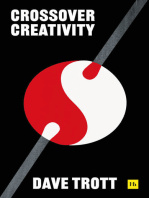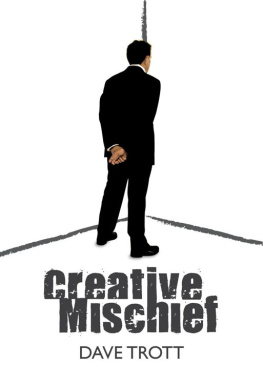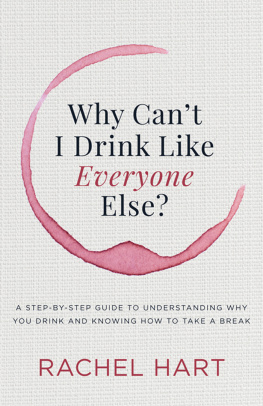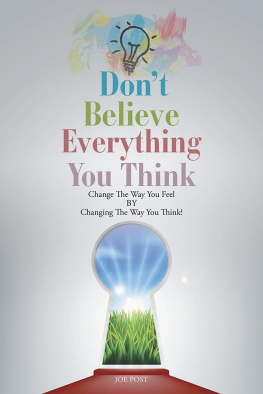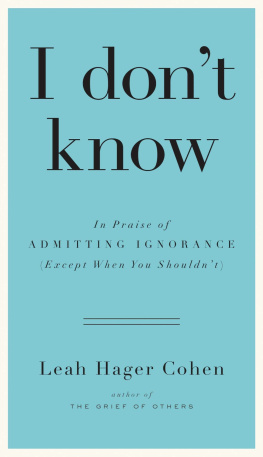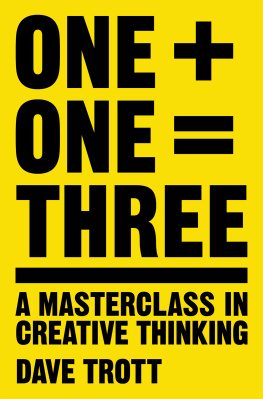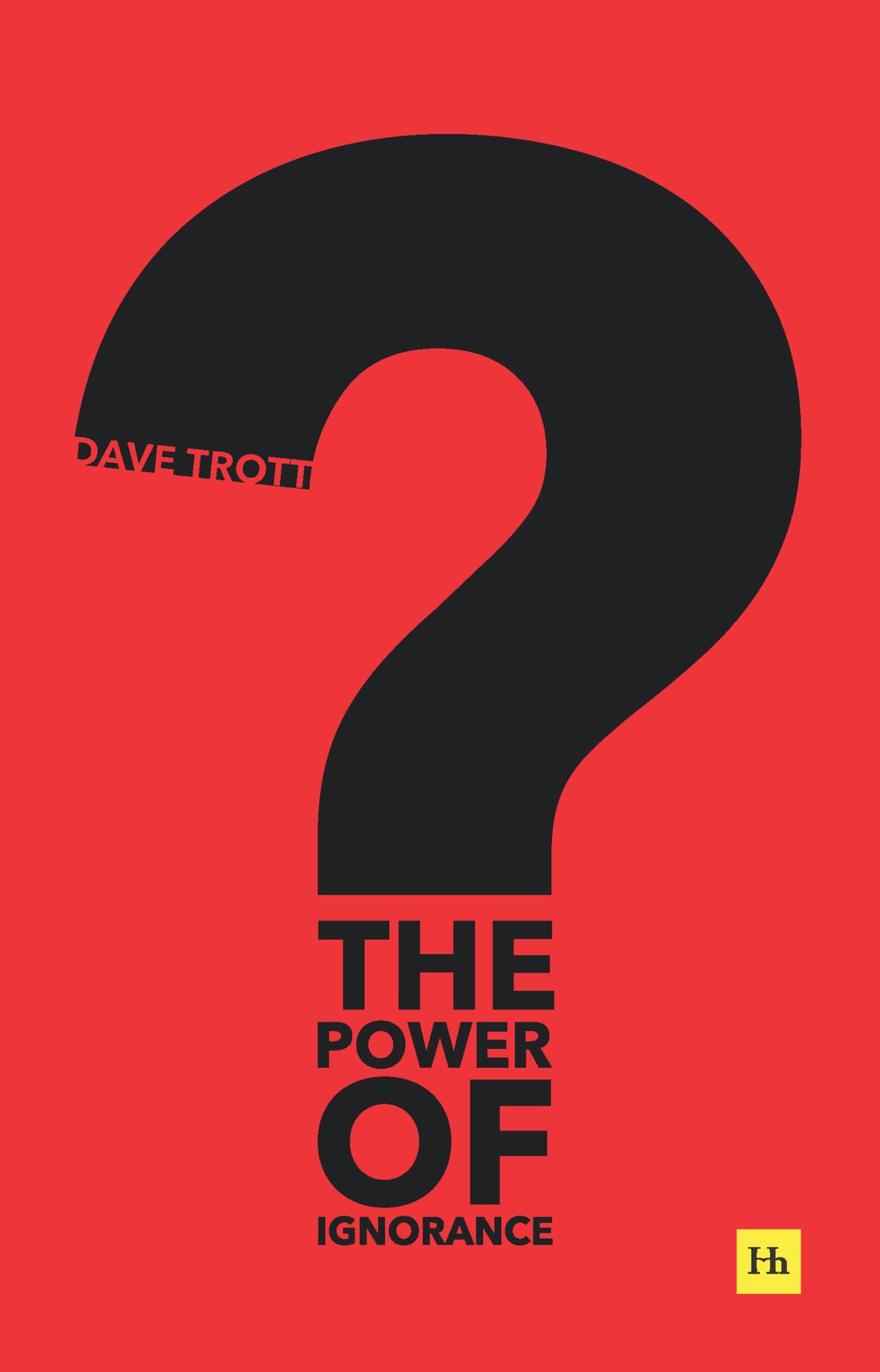The Power of Ignorance
How creative solutions emerge when we admit what we dont know
Dave Trott

CONTENTS
Also by Dave Trott
Creative Mischief
Predatory Thinking
One Plus One Equals Three: A Masterclass in Creative Thinking
Creative Blindness
ABOUT THE AUTHOR
Dave Trott is a creative director, copywriter and author. He studied at the Pratt Institute in New York City, majoring in advertising before going on to found the advertising agencies Gold Greenlees Trott, Bainsfair Sharkey Trott and Walsh Trott Chick Smith. In 2004 he was given the D&AD Presidents Award for lifetime achievement in advertising. He has also received lifetime achievement in advertising awards from The Creative Circle, The Marketing Society, and The Scottish Advertising Association.
Dave is married with two children and lives in London. The Power of Ignorance is his fifth book.
INTRODUCTION
I always learned more from stories than from lectures.
This book is written for people like me.
Theres a story about an American student of Buddhism who travels to the mountains to see an elderly Buddhist master.
He wishes to learn from him, so they sit cross-legged on the floor as tea is served.
The student is nervous, he wants to impress the master with his knowledge.
He starts telling him everything he knows about Buddhism.
The master begins pouring tea into the students cup.
The student mentions all the books he has read, every famous teacher he has studied.
The master continues pouring tea into the students cup.
The student mentions every monastery he has visited, he begins to get nervous as his cup begins to fill.
The master continues to pour tea into the cup.
The student is talking faster and faster about all the different forms of meditation he has tried, he cant take his eyes off the cup which is now full to the brim.
The master continues pouring and the cup overflows.
The master continues pouring as the tea runs across the table and down onto the floor.
The student shouts: Stop, stop, why are you still pouring? The cup is full, it cant take anymore.
The teacher says: Your mind is like this cup it is so full there is no room for anything else. Like the cup, you must empty your mind before it can accept anything new.
That is the problem most of us have.
We are scared stiff to let go of what we know, we acquire knowledge and cling onto it, consequently we can never learn anything new.
As Adlai Stevenson said: Most people approach every problem with an open mouth.
We feel we must be the first to offer a solution.
We think knowledge is strength and ignorance is weakness.
But all that actually ensures is we offer a solution from the range of options that already exist, we never learn anything new.
We never learn anything new because we never ask questions.
We never ask questions because were afraid to say I dont know.
We never say I dont know so we can never discover anything new.
Our cup is full to overflowing.
Socrates was involved in a discussion with Meno, who believed his forceful opinion would win him the argument.
Socrates said: I am wiser than this man, for neither of us appears to know anything great and good, but he fancies he knows something, although he knows nothing; whereas I, as I do not know anything, so I do not fancy I do. In this trifling particular, then, I appear to be wiser than he, because I do not fancy I know what I do not know.
Lao Tzu (the father of Taoism) put it more simply: The wise man knows he doesnt know. The fool doesnt know he doesnt know.
What both of these men were saying concerns the way to approach a problem.
Contrary to the conventional belief, there is actually weakness in knowledge and strength in ignorance.
Ignorance, properly used with curiosity, allows us to find out things we didnt know.
And that NEW knowledge allows us to come up with new solutions.
Solutions that werent visible from the previous position of existing knowledge.
This entire book is about asking questions, because creativity is about asking questions.
Using ignorance as a torch, to uncover what everyone else has walked over, unaware.
Because ignorance coupled with curiosity results in questions that no one else is asking.
Questions like: how could Pepsi sell cola to Russia when Coca-Cola couldnt?
How did IBM build the biggest computer company in the world in a depression?
How could a madman and a murderer be the saviour of the English language?
How do you sell glassware to people whove already got all the glassware they need?
How did George Washingtons friends kill him with too much knowledge?
How did the competition build Uber by trying to kill it?
How did an expert create the useless rule of passwords that everyone still believes?
How and why did Disney create the myth of lemmings?
How and why did the cleverest and most famous people in the world lose billions?
How do you build a brand out of purposely not having any brand at all?
Our mind is like that students cup.
We cant put anything new into it until we first empty it.
Thats how we use ignorance, as a tool to empty the cup so we can fill it with new knowledge.
Ignorance coupled with curiosity is where all new knowledge starts.
Ignorance, used properly, is our secret weapon.
PART 1: WHAT YOU DONT KNOW YOU DONT KNOW
THE ANSWER ASKS THE QUESTION
In 1942, Britain was losing the battle of the Atlantic, which meant they were losing the war.
This has a way of concentrating the mind, so they were prepared to try anything.
One of the desperate moves was to try war-gaming.
All that could be spared was a retired naval officer and eight young Wrens, for a group called Western Approaches Tactical Unit (WATU).
The young Wrens knew nothing of anti-submarine warfare of course.
This meant they had lots of questions.
As with any problem, questions are always a good place to start.
Q) Whereabouts in the convoy are the ships being attacked?
A) Usually in the centre, at night.
Q) How big is the convoy?
A) About 8 miles square.
Q) What is the torpedoes range?
A) About 2 miles.
Conclusion : the U-boats must be attacking from inside the convoy. Torpedoes cant reach the centre from outside.
Q) What is the convoys speed?
A) Around 10 knots.
Q) What is a U-boats speed?
A) 16 knots on the surface, 6 knots submerged.
Conclusion : the U-boats are attacking on the surface, they are too slow when submerged.
Q) How long does it take to reload the torpedoes?
A) About half an hour.
Q) Would they do this on the surface?
A) No, they would submerge.
Conclusion : after an attack, a U-boat will submerge and be left behind by the convoy.
They will then have to surface to catch up.
In having to answer the Wrens questions, the naval officer had to think like a U-boat commander, and that was the first time anyone had done that.
Instead of rushing around after the first ship exploded, they realised the destroyers had some time while the U-boat reloaded.
They could let the convoy pass on and, after it was gone, search for the U-boats that were reloading.
Because they were submerged they were slower, and the destroyers could use ASDIC (underwater radar) to locate them.


